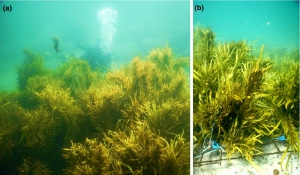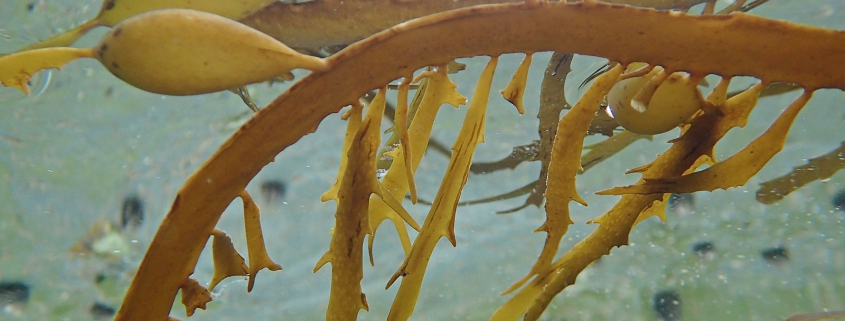Genomic vulnerability of a dominant seaweed species points to future-proofing pathways for Australia’s underwater forests
By Rebecca VanArnam, SRC Intern
Endemic to Australia, Phyllospora comosa “is a forest-forming seaweed inhabiting the south-eastern Australian coastline that supports vital ecosystem functions” (Wood, 2021) (Figure 1). Like other species, climate change is causing biological changes within seaweed and seaweed-dependent organisms (Wernberf, 2011). As climate change impacts this seaweed species in Australia, scientists look to find adaptation patterns that the organism may possess. An organism’s genome can be assessed and used to understand how organisms adapt to changing environments.

Figure 1: A photograph providing an image of Phyllospora comosa at a restoration site. (a) Represents an area that was restored (b) represents donor Phyllospora comosa to the area. [Image source: Coleman, 2017]
The analysis found that the Phyllospora comosa have relatively high gene flow, which means that their genetic material passes from one population to another, connecting their generations. The results also showed that genetic diversity was lower close to the edges of the species’ range. When linking these results to future climate change and fluctuating temperatures, it became evident that ocean warming is a definite threat to the populations where local adaptation is most likely occurring (Figure 2). This causes the central range, where diversity is highest, to be recognized as the most vulnerable area for the Phyllospora comosa (Wood, 2021).

Figure 2: A close-up photograph of the complexity of Phyllospora comosa [Image source: Wikipedia/ Phyllospora comosa]
Works Cited:
Coleman, M. A., & Wernberg, T. (2017). Forgotten underwater forests: the key role of fucoids on Australian temperate reefs. Ecology and Evolution, 7(20), 8406-8418.
Liggins L., Treml E.A., Riginos C. (2019) Seascape Genomics: Contextualizing Adaptive and Neutral Genomic Variation in the Ocean Environment. In: Oleksiak M., Rajora O. (eds) Population Genomics: Marine Organisms. Population Genomics. Springer, Cham. https://doi.org/10.1007/13836_2019_68
Wernberg, Thomas, et al. “Seaweed Communities in Retreat from Ocean Warming.” Current Biology 21.21 (2011): 1828-32. Print.
Wood, Georgina, et al. “Genomic Vulnerability of a Dominant Seaweed Points to Future‐Proofing Pathways for Australia’s Underwater Forests.” Global Change Biology (2021). Print.



